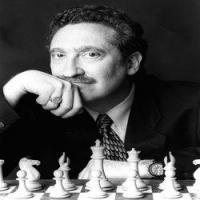
Pandolfini's Puzzler #62: The Straight and Narrow
Professor: Good afternoon, chess players! I hope you’re ready for some chess.
It was almost possible to discern a modicum of interest.
Hale: Where are we headed today, Professor?
Professor: I thought we’d look at some composed mates.
Rachel: Any particular theme in mind?
Professor: Geometry.
Ryan: What do you mean, Professor?
Professor: I’m referring to the way pieces line up, either at the start of a composition, or at its end.
Lucian: You mean the patterns?
Professor: Yes.
Zephyr: What pattern were you thinking of showing today?
Professor: The straight line.
Thomas: The straight line?
Zephyr: Like the shortest distance between two points?
Idris: On earth, that’s a geodesic.
Zephyr: Are we on earth? I wasn’t sure.
Professor: Back on the chessboard, here’s our first problem.
Question 1: How does White force mate in 2 moves?
Lucian: That’s not very hard, Professor.
Rachel: But it’s straight.
Hale: Yeah, the forces do line up vertically.
Professor: Let’s see one where they line up horizontally.
Question 2: How does White force mate in 2 moves?
The group found this idea very straightforwardly.
Ryan: Professor, this problem’s lineage is questionable. I know I’ve seen similar setups.
Idris: So have I. Actually, the bishop isn’t even a meaningful factor.
Hale: Well, it makes the line longer.
Idris: Not that materially.
Zephyr: A bishop isn’t material?

Professor: Materially, immaterially, I think it’s time for another vertical conception.
Question 3: How does White force mate in 2 moves?
This one was definitely harder, though just as straight. Nevertheless, the team of dedicated young players worked out the right move and straightened out its linear points.
Ryan: I liked that one.
Hale: And it did require us to discriminate between two reasonable first moves.
Zephyr: Any more straight lines in your two dimensional universe?
Professor: Absolutely, though I don’t want to cross you up. Even so, I think it’s time to go horizontal again.
Question 4: How does White force mate in 2 moves?
Another tricky one, but it was just a matter of finding a subtle first move. It was Rachel who found it.
Thomas: That was challenging.
Hale: Especially with the possibility of an underpromotion.
Lucian: Those were all 2-movers. Don’t you have any 3-movers?
Professor: Coming right up.
Question 5: How does White force mate in 3 moves?
Surprisingly, the group took a bit longer on this one. Eventually, Ryan came up with one winning variation, and Idris found another, at that, a mirror image.
Zephyr: That was nice, Ryan and Idris.
Lucian: Nice? Did I hear you say something nice about some people.
Zephyr: You never know. Maybe you’ll be next.
Professor: Next? How about our next problem?
Question 6: How does White force mate in 3 moves?
Everybody went awry on this one. Still, on second thought, it didn’t take long to find the solution.
Ryan: Are we back to the same idea again?
Hale: It’s a little different.
Rachel: Can we see something even more different?
Professor: Well, see what you can do with 4 minor pieces.

Question 7: How does White force mate in 5 moves?
Now this was truly tougher, though not for Idris. He had to bow out because he had seen the problem before. But Ryan and crew were able to work out the subtleties anyhow, and the mate was unearthed.
Lucian: You’ve seen that before, Idris?
Idris: Yes, in a book of Russian composed mates.
Zephyr: The book was in russian?
Idris: Of course.
Zephyr: I think I’m getting tired of all these horizontal and vertical lines.
Professor: Okay. Let’s put a new slant on things.
Question 8: How does White force mate in 2 moves?
This proved to be too easy and the group started grumbling.
Rachel: It seems a shame to end the class on such an easy problem.
Professor: Well, we don’t have to.
Hale: You mean you have another one-liner?
Professor: No, let’s end the class with the forces, not in one line, but in two.
Question 9: How does White force mate in 4 moves?

This final problem took some time, but led by Idris and Ryan, the group polished off all the variations.
Zephyr: I think we’ve had enough one-liners.
Lucian: Zephyr, does that mean you don’t have your usual one-liner to close out the session?
Zephyr: No, I do have a one-liner. But if I say it with a straight face, I’m going to need two lines.
Answers below -- Try to solve NM Pandolfini's puzzles first!
Answer 1: White wins with 1. Qa5 Kb7 2. a8/Q mate.
Answer 2: In this problem, based on a 1923 composition by R. L’hermet, the centralization 1. Qd5 does the trick.
If 1…Ka6, then 2. Qa8 mate.
If 1…Ka4, then 2. Qa2 mate.
Meanwhile, if 1…Be8 (to block at a4), then 2. Qa8 mate.
Or 1…Be2 (to block at a6) 2. Qa2 mate.
Answer 3: Based on a 1967 problem by M. Rosenthal, the key move is 1. Qg2!.
If 1…Ng4, then 2. Qc2 mate.
If 1…Ne4 (or 1…Nd3 or 1…Nh3), then 2. Qg6 mate.
And if 1…f3, then 2. Qxf3 mate.
Note that 1. Qe2 fails to 1…Ne4, delaying the mating effort.
Answer 4: The mate in two is set up by 1. Qa3!.
If 1…c1/Q (or 1…c1/R or 1…c1/B), then 2. Qd3 mate.
If 1…c1/N, then 2. Qb2 mate.
And if the knight moves (say 1…Ne1), then 2. Qe3 mate.
Answer 5: Composed by V. Kalandadze, the mate in 3 begins with a retreat, 1. Kd4!.
If 1…Kc8, then 2. Qb6 d6 (or 2…d5) 3. Bg4 mate.
Or if 1…Ke8, then 2. Qf6 d6 (or 2…d5) 3. Ba4 mate.
Answer 6: In a position inspired by a 1923 creation of R. Garraux, the quick win begins with 1. Qd4! (another nice centralization).
If 1…Kh5, then 2. Qg7, threatening mate at g5, when 2…Kh4 is finished by 3. Qxg4 mate.
If instead 1…Kh3, then 2. Qg1 wins comparably to the previous variation. That is, White threatens mate at g3, and 2…Kh4 is again met by 3. Qxg4 mate.
Answer 7: The mate here in a problem composed by Y. Selyavkin in 1984 is a twinge more intricate.
The winning line is 1. Bf3! Kg5 2. Be3+ Kh4 (2…Kg6 is answered by 3. Be4 mate) 3. Bf4 Kh3 4. Nf2+ Kh4 (on 4…Kh2 White has 5. Ne2 mate) 5. Nf5 mate.
Answer 8: The diagonalized array leads to a 2-move mate beginning with 1. Kf6.
If 1…Kh8, then 2. Rd8 mate.
If 1…Kg8, then again 2. Rd8 mate.
And if 1…Kh6, then 2. Rh3 mate.
In many endgames, it’s helpful to be aware of the inner box of squares, with boundaries defined by the lines c3-c6-f6-f3-c3. The attacking king often pivots to advantage on the corners of that inner box.
Answer 9: The starting move is 1. Qa4!.
Black is then reduced to 5 rook moves or 2 king moves.
If 1…Rb8, then 2. Qa2+ Kh8 3. Qh2+ Kg8 (if 3…Kf8, then 4. Qf7 mate) 4. Qxb8 mate (a right triangle mate).
If 1…Rc8, then 2. Qb3+ Kh8 3. Qh3+ Kg8 (if 3…Kf8, then 4. Qf7 mate) 4. Qxc8 mate (a right triangle mate).
If 1…Rd8, then 2. Qc4+ Kh8 3. Qh4+ Kg8 4. Qxd8 mate (a right triangle mate).
If 1…Re8, then 2. Qxe8 mate (a right triangle mate).
If 1…Rf8, then 2. Qc4+ (or 2. Qb3+ or 2. Qa2+) Kh8 3. Qh4+ Kg8 4. Qh7 mate (a support mate).
Black of course could play either 1…Kf8 or 1…Kh8, instead of moving the rook.
If 1…Kf8, then 2. Qd7, threatening mate at f7, is crushing, since 2…Kg8 3. Qd5+ (another powerful centralization) Kh8 (or 3…Kf8 4. Qf7 – a support mate) 4. Qxa8 mate (a simple back row mate) signals the end.
Take note:
To be sure, problem composers love arranging pieces in geometric patterns. Straight lines are just a part of their imaginative creations.
They also deploy forces in triangles, squares, crosses, and all kinds of mirror images.
When displayed well, and not too obviously, such deployments can add greatly to a problem’s finely tuned qualities and appreciation.
RELATED STUDY MATERIAL
- Watch IM PlayfulSquirrel's video on how to place your queen in the endgame.
- Check out Bruce Pandolfini's previous article, Puzzler #61.
- Perfect your tactics at the ChessKid puzzles trainer.

